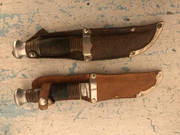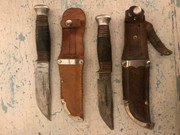 ed_is_dead
ed_is_dead
:
At this point i'm quite certain that the steel in these 2 knives is an entirely different type when compared to the standard Sheffield made crucible cast steel.
One reason is that Pontus Holmberg classifies it as a stainless steel, where the Sheffield made crucible cast steel was a carbon steel.
See this detail picture of the sheath of knife #2, and "Rostfri" is the Swedish word for stainless.
Image GEDC4173 hosted in ImgBB

ibb.co
The second reason is the very high wear resistance of this Swedish steel: using whatever grit of black silicon carbide on it is extremely slow, be it waterproof SiC paper or the coarse black SiC side of the Foss 7205 combination stone.
The green silicon carbide side of that stone however, even though much finer than the black side, cuts the steel noticeably faster, better, and also with great feedback.
Based on this i'm beginning to suspect there might be quite a lot of tungsten carbides in it, also because the steel is able to take & hold a thin ~20 degree inclusive edge angle while whittling an old piece of hard beechwood cutting board (tested with knife #1)
A possible third reason is a little piece of info i found on this website with mining data:
https://www.mindat.org/loc-3153.html
According to this there could be (traces of) silver in the Dannemora iron ore, which made me remember what Faraday wrote about the alloy of steel with silver in this thread:
https://www.bladeforums.com/threads...cus-wootz-other-alloys.1666437/#post-20358902
Problems might be that Faraday wrote about his findings around 1822, he doesn't talk about silver in ore but about lab made alloys, and i'm no metallurgist.
Maybe
 Larrin
Larrin
can tell us more about the validity of Faraday's claims about steel alloyed with silver, and maybe his thoughts about the type of steel in these two Swedish knives.




























